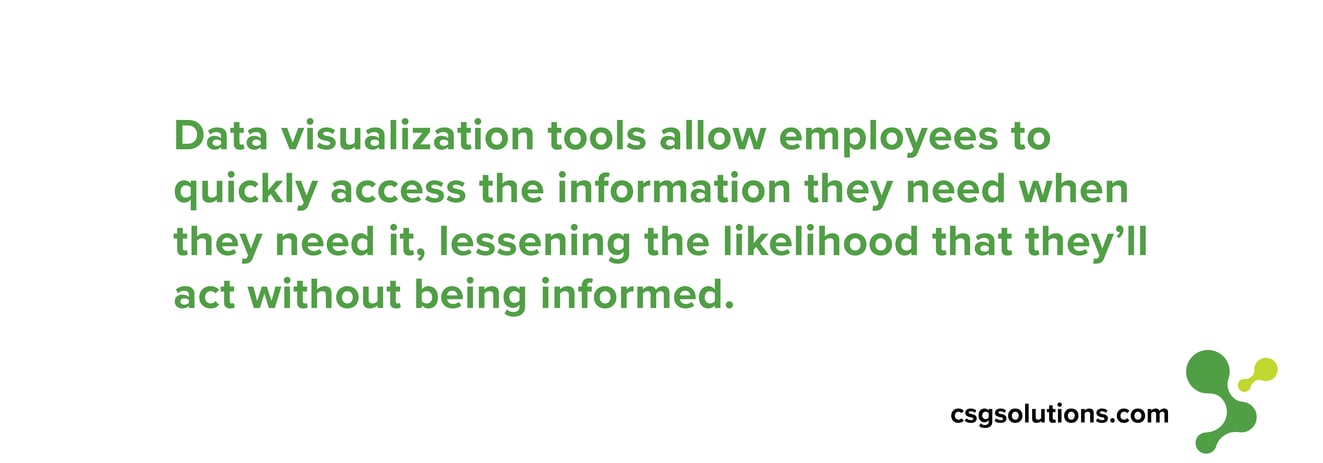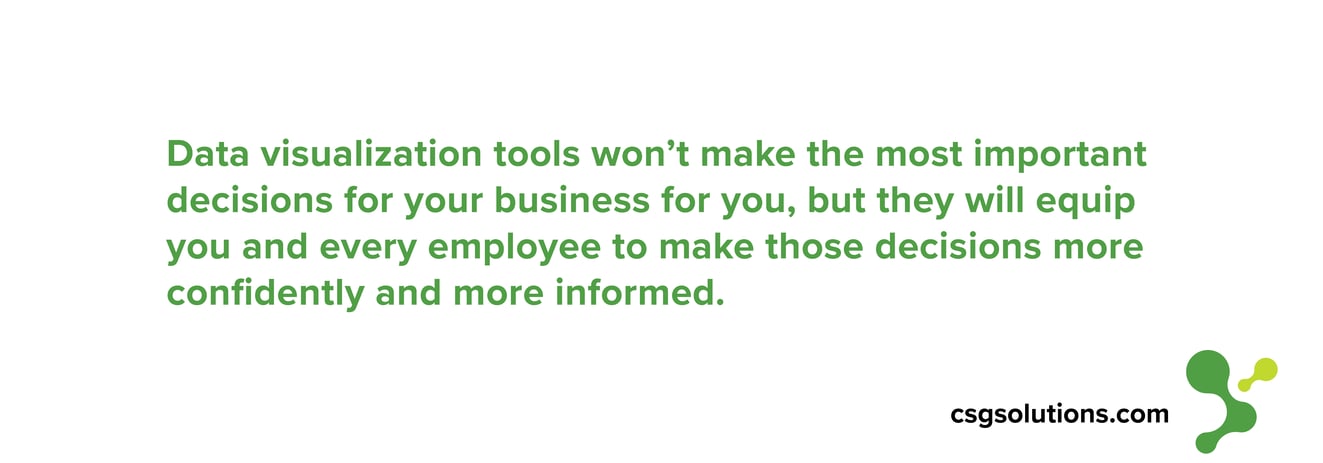The Complete Guide to Data Visualization Tools for Business Owners
Data visualization tools allow anyone to digest data quickly and easily by making a way to create charts, graphs, and visual plots from data so that it can be easily understood and manipulated. Rather than searching for trends in excel spreadsheets, data visualization tools like Tableau or Power BI allow you to explore the data visually.
Using simple data visualization tools accelerates the speed at which we can comprehend this data and makes the data more salient to our visually-biased minds. Black and white data on a spreadsheet suddenly jumps out at you when shown in a chart form. This is because 90% of the information that is transmitted to the brain is visual, and human brains process visuals 60,000 times faster than they do text. When looking to gain insight from your data, creating visualizations using an effective data visualization tool will be far more effective than looking through data on an excel spreadsheet.
Even further, it’s proven that people are more likely to believe any information if it presented as a visual rather than a spreadsheet. Creating visualizations will not only increase efficiency in your business, but will improve the quality and amount of actions taken as a result of “seeing the numbers”. The mere presence of a chart over a spreadsheet is more persuasive.
In a world that is increasingly digital, where businesses are constantly looking to generate more value from the increasing amounts of data they collect, having access to your data is a huge differentiator. We’ve seen time and time again that organizations that capture and accurately interpret data about their customers are the most successful and stand out in their markets. Access to insight and information makes the difference.
In this blogpost we’ll cover how data visualization tools can help your business, signs that your company could benefit from data visualization, the many benefits and features of data visualization tools, and how to choose the right tool and ensure long-term success after installation.
Data Visualization Tools Can Help Your Business…
- Identify new market opportunities
- Improve customer experiences and outcomes
- Gain insight into customer behavior (Use this information to pre-empt trends and do more of what customers are responding well to)
- Increase operational productivity and efficiency
- Prioritize improvement efforts by identifying problem areas (You can’t fix the problem until you know what the problem is)
- Improve response time to underperforming areas of your business
- Access information about your day-to-day business operations in real time (instead of having to wait on weekly or monthly reports)
- Improve the visibility and control of day-to-day business operations
- Shorten business meetings (This is due to the fact that people understand reasoning and information more quickly when it is presented as a visualization, shortening discussion time needed for understanding)
- Effectively communicate the value and data behind new business opportunities and initiatives to key stakeholders
- Quickly identify under-served territories and channels for expansion
- Understand the source of past problems in your business to prevent them from happening in the future
- Forecast and predict what could happen according to current trends in your business
- Automate data collection and reporting, reducing the likelihood that the data might be copied inaccurately
- Cut costs by accurately identifying and discontinuing unprofitable product lines, processes, and labor
- Price products more profitably
- Manage promotional and incentive programs with fewer resources and less risk
- Improve IT’s efficiency by giving employees role-based access to the information they need
- Optimize onboarding and training
Overall, data visualization tools can help you make any decision you need to make for your business more quickly and more informed. According to Forbes, companies who utilize Business Intelligence Analytics are five times more likely to make faster-than-average decisions. If you’re looking to get ahead of the competition, data visualization tools and greater access to your data could be your key to success.
With greater access to data through data visualization tools, you will have a greater understanding of the day-to-day operations and health of your business. With more informed decision-making, the benefits to your bottom line and operations will come naturally.
Even more, by allowing every employee to have that access to data visualization tools, you are equipping your whole company to make more decisions based on the same information you see. Instead of having information only available to certain departments or when reports are published by the IT team, data visualization tools allow employees to quickly access the information they need when they need it, lessening the likelihood that they’ll act without being informed. It will be far easier for anyone throughout your organization to identify opportunities and make better decisions for your business.

Signs that Your Company Could Benefit from Using Data Visualization Tools:
- You don’t understand why an initiative didn’t produce the results you wanted
- You can’t seem to get ahead of the competition
- You can’t identify exactly why you are succeeding or failing
- You aren’t generating a profit from your database by learning how to interact with your customers
- You still rely on your IT team or analysts to build reports
- You have to access several systems to get the information you need about your company’s customers, products, revenues, costs, and employees
- You can’t perform analysis across multiple departments
Data visualization tools solve all these problems for a company, and more. Here are a few of the benefits of using data visualization tools over manual reporting or having reporting and analysis only available through your IT team or not cross-departmentally:
Greatest Benefits of Using Data Visualization Tools:
- Everyone in your organization will have access to the same data and fresh data.
Data visualization tools always use the most up-to-date data available in the organization. When your company’s data strategy incorporates data visualization tools and uses them to their maximum potential, all employees will have access to fresh information. And better yet, the information will be consistently available across your organization. This gives not only leadership but every employee the ability to adopt a proactive rather than reactive attitude with your data. Instead of making decisions on old data, your employees will always have the most up-to-date information. - Data visualization tools minimize the use of guesswork and making gut-feeling decisions.
With easy access to data visualization tools and adequate training, you can eliminate the amount of guesswork that often is a part of decision-making. The culture of your organization can transform into one where quantitative decision-making is valued, because your employees are equipped with the information they need. - IT doesn’t have to be the sole source of reports.
With data visualization tools, anyone can have access to role-based analysis, saving your organization an incredible amount of time and money. IT will be able to focus more time on other priorities (data governance, security) rather than pulling reports. - Manual reporting for cross-departmental analytics is a thing of the past.
Data visualization tools eliminate the need to manually gather data and compile it into a spreadsheet. They can pull data from disparate sources, generating comprehensive reports in moments. You will no longer be digging through Excel files wondering if you have the right version. - Reduce the risk for human error in reporting.
Use of data visualization tools removes the element of human error from your reports. Whereas manual reporting requires someone to copy and paste data and prepare it, and thereby accidentally altering the data in the process, data visualization tools don’t require people to handle the data in that way at all. No longer could one bad keystroke compromise the veracity of your data. You’ll be able to trust that the visualizations you are seeing are accurate and trustworthy. - Visual analysis is faster than sorting through spreadsheets.
Employees will be able to make comparisons more quickly between data sets because it will be presented visually, increasing their efficiency. Because they can generate quick, hassle-free insight in a way they understand easily, they’ll be more likely to go back to the information to make decisions in the future. - Govern your data with role-based access.
You can control who is able to view, modify, and input new data with role-based access. With this ability to govern, you can make data available as needed to an unlimited amount of users across your organization and all departments. - Customize dashboards and visualizations based on your users.
With data visualization tools, each user can customize their own dashboard and create the visualizations that are the most useful to them. They can organize their dashboard to have their most frequently used visualizations readily available, increasing the likelihood that they’ll come back to them to make data-informed decisions time and time again.
Choose the Right Data Visualization Tool for Your Business
Every business will have different needs when it comes to choosing the right data visualization tool, and the solution will often change based on the different type of access needed, level of experience and data literacy of your users, what types of questions you’re looking to answer, and what data sources you’re looking to pull from. We’ve suggested a few of our favorites below, and we’d be glad to help you find the data visualization tool that’s a perfect fit for your business’ needs.
Tableau:
Tableau is a long-time leader in providing a data visualization tool that is user friendly yet power-packed with capabilities and opportunities for insight. With powerful drag-and-drop analytics, a variety of role-based access options, and the ability to share data and insights with other users, Tableau equips employees from all levels of your organization to dive deep into data for decision-making and share their insight. Users can quickly access data in real-time and build powerful visualizations with Tableau’s interactive dashboard. If you’re interested in trying out Tableau fill out the contact form below to get in touch and we’ll help you with a guided evaluation.
Power BI:
With Power BI, Microsoft’s business intelligence solution, you can quickly connect to data, prep it, model, and visualize as much or as little as you like, and securely share insights both inside and outside of your organization. Power BI connects to data sources on premise, in the cloud, or even from social networks and other marketing integrations. Users can connect to hundreds of data sources all at once to create visualizations and discover new insights. Get in touch at the form below to learn more about Power BI as a solution for your business.

Ensure Success with a Data-Driven Culture
Ultimately, success with data visualization tools comes from developing a data culture, not just by providing access to data visualization tools. Tableau shares that only 8% of organizations that invest in analytics solutions achieve analytics at scale, and a data culture is what sets those organizations apart.
A data-driven culture is one that values data more than anything else; more than intuition, anecdotes, or rank. In a data-driven organization, the example of valuing data is set by leadership. No one is above stopping to look further into the data, because they trust that looking at the data gives them the greatest chance for success.
In companies that successfully scale their data analytics solutions, discussions start with looking at the data, and initiatives start and end because the data is or isn’t there to support it. From idea to decision, data is involved. To learn more about the necessity of creating a data-driven culture to complement your data analytics tools, read our recent blogpost: “Data Culture- The Only Way to Achieve Analytics at Scale”.
Make data driven decisions confidently.
Read our guide to effective Tableau training.


